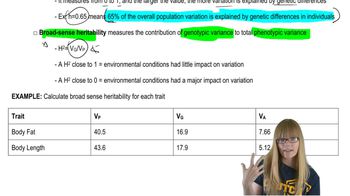What are considered significant factors in maintaining the surprisingly high levels of genetic variation in natural populations?
Table of contents
- 1. Introduction to Genetics51m
- 2. Mendel's Laws of Inheritance3h 37m
- 3. Extensions to Mendelian Inheritance2h 41m
- 4. Genetic Mapping and Linkage2h 28m
- 5. Genetics of Bacteria and Viruses1h 21m
- 6. Chromosomal Variation1h 48m
- 7. DNA and Chromosome Structure56m
- 8. DNA Replication1h 10m
- 9. Mitosis and Meiosis1h 34m
- 10. Transcription1h 0m
- 11. Translation58m
- 12. Gene Regulation in Prokaryotes1h 19m
- 13. Gene Regulation in Eukaryotes44m
- 14. Genetic Control of Development44m
- 15. Genomes and Genomics1h 50m
- 16. Transposable Elements47m
- 17. Mutation, Repair, and Recombination1h 6m
- 18. Molecular Genetic Tools19m
- 19. Cancer Genetics29m
- 20. Quantitative Genetics1h 26m
- 21. Population Genetics50m
- 22. Evolutionary Genetics29m
21. Population Genetics
Allelic Frequency Changes
Problem 22
Textbook Question
Tay–Sachs disease is an autosomal recessive neurological disorder that is fatal in infancy. Despite its invariably lethal effect, Tay–Sachs disease occurs at very high frequency in some Central and Eastern European (Ashkenazi) Jewish populations. In certain Ashkenazi populations, 1 in 750 infants has Tay–Sachs disease. Population biologists believe the high frequency is a consequence of genetic bottlenecks caused by pogroms (genocide) that have reduced the population multiple times in the past several hundred years.Assuming mating occurs at random in this population, what is the probability a couple are both carriers of Tay–Sachs disease?
 Verified step by step guidance
Verified step by step guidance1
Step 1: Understand the inheritance pattern of Tay–Sachs disease. It is an autosomal recessive disorder, meaning an individual must inherit two copies of the defective allele (one from each parent) to express the disease. Carriers have one defective allele and one normal allele, and they do not exhibit symptoms.
Step 2: Use the given information to determine the frequency of individuals affected by Tay–Sachs disease in the population. The problem states that 1 in 750 infants has Tay–Sachs disease. This represents the frequency of homozygous recessive individuals (q²) in the population.
Step 3: Apply the Hardy-Weinberg principle to calculate the allele frequency of the recessive allele (q). The equation for homozygous recessive individuals is q² = frequency of affected individuals. Solve for q using the equation q = √q².
Step 4: Calculate the frequency of carriers (heterozygous individuals) in the population using the Hardy-Weinberg equation. The frequency of carriers is given by 2pq, where p is the frequency of the dominant allele and q is the frequency of the recessive allele. Use the relationship p + q = 1 to find p.
Step 5: Determine the probability that a couple are both carriers. Since mating is random, the probability that one individual is a carrier is 2pq. The probability that both individuals in the couple are carriers is the product of their individual probabilities, which is (2pq) × (2pq).
 Verified video answer for a similar problem:
Verified video answer for a similar problem:This video solution was recommended by our tutors as helpful for the problem above
Video duration:
2mPlay a video:
Was this helpful?
Key Concepts
Here are the essential concepts you must grasp in order to answer the question correctly.
Autosomal Recessive Inheritance
Tay-Sachs disease is inherited in an autosomal recessive manner, meaning that an individual must inherit two copies of the mutated gene (one from each parent) to express the disease. Carriers, who have only one copy of the mutated gene, do not show symptoms but can pass the gene to their offspring. Understanding this inheritance pattern is crucial for calculating carrier probabilities in a population.
Recommended video:
Guided course

Autosomal Pedigrees
Hardy-Weinberg Principle
The Hardy-Weinberg principle provides a mathematical framework for understanding genetic variation in a population at equilibrium. It states that allele and genotype frequencies will remain constant from generation to generation in the absence of evolutionary influences. This principle is essential for estimating the frequency of carriers in a population, particularly when considering random mating.
Recommended video:
Guided course

Hardy Weinberg
Carrier Frequency Calculation
To determine the probability that a couple are both carriers of Tay-Sachs disease, one must calculate the carrier frequency in the population. This involves using the allele frequency of the Tay-Sachs mutation and applying it to the Hardy-Weinberg equation. The carrier frequency can then be squared to find the probability that two randomly selected individuals are both carriers.
Recommended video:
Guided course

Calculating Heritability
Related Videos
Related Practice
Textbook Question
366
views


